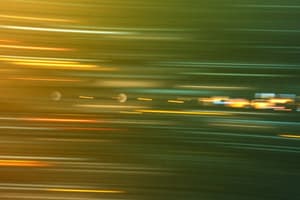Podcast
Questions and Answers
What is the primary external force involved in running?
What is the primary external force involved in running?
- Inert tissues
- Muscles
- Gravity (correct)
- Friction
Which muscle groups are the most important for producing power in running?
Which muscle groups are the most important for producing power in running?
- Biceps and triceps
- Pectorals and deltoids
- Hip flexors, extensors, abductors, knee extensors, and calf muscles (correct)
- Quadriceps and gluteus maximus
What is the force element involved in running?
What is the force element involved in running?
- Strength
- Endurance
- Power (correct)
- Agility
Which muscles extend the hip to move the body forward during the first part of stance?
Which muscles extend the hip to move the body forward during the first part of stance?
What do the quadriceps and calf muscles do to continue to propel the body forward in running?
What do the quadriceps and calf muscles do to continue to propel the body forward in running?
What is the additional efficiency provided by the hip abductors in running?
What is the additional efficiency provided by the hip abductors in running?
What provides additional energy during tendon and muscle recoil in running?
What provides additional energy during tendon and muscle recoil in running?
What is the musculotendinous unit working likened to in running?
What is the musculotendinous unit working likened to in running?
Which phase does the musculotendinous unit gain energy in running?
Which phase does the musculotendinous unit gain energy in running?
What is the effect of the energy gained from the musculotendinous unit and the tendon in running?
What is the effect of the energy gained from the musculotendinous unit and the tendon in running?
What are the internal forces produced by in running?
What are the internal forces produced by in running?
Which muscle group extends the knee in running?
Which muscle group extends the knee in running?
Flashcards are hidden until you start studying
Study Notes
- Kinetics studies forces that cause motion, including internal and external forces in running.
- Internal forces are produced by the body's muscles and inert tissues, while gravity is the primary external force.
- Power is the force element involved in running.
- Hip flexors, extensors, abductors, knee extensors, and calf muscles are the most important muscle groups producing power for running.
- Gluteus maximus and hamstrings extend the hip to move the body forward during the first part of stance.
- Quadriceps extend the knee and calf muscles plan- tarflex the ankle to continue to propel the body forward.
- The hip abductors may provide additional efficiency by keeping the pelvis stabilized laterally.
- The stretch reflex provides additional energy during tendon and muscle recoil.
- Musculotendinous unit working is likened to a spring that gains energy during the absorption phase and releases it during the propulsion phase.
- The energy gained from the musculotendinous unit and the tendon adds to their desired motion to create a stronger, more powerful effect.
Studying That Suits You
Use AI to generate personalized quizzes and flashcards to suit your learning preferences.




